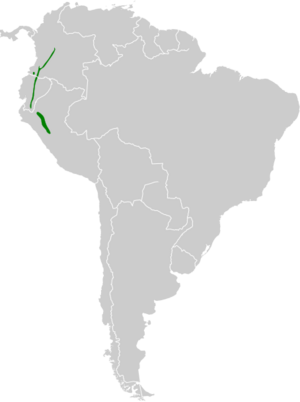Emerald-bellied puffleg facts for kids
The emerald-bellied puffleg (Eriocnemis aline) is a type of hummingbird. It's known for its bright green belly and fluffy white leg feathers, which look like little puffs! You can find this tiny bird in the mountains of Colombia, Ecuador, and Peru.
Quick facts for kids Emerald-bellied puffleg |
|
|---|---|
 |
|
| Conservation status | |
| Scientific classification | |
 |
Contents
About This Bird's Family
The emerald-bellied puffleg has two main types, called subspecies: E. a. aline and E. a. dybowskii. These are like different versions of the same bird.
It is very similar to the colorful puffleg (E. mirabilis). Some scientists think they are very close relatives. Their feathers look quite different from other pufflegs. Because of this, one expert even suggested they might belong in their own special group!
What Does It Look Like?
The emerald-bellied puffleg is the smallest of all the pufflegs. It is about 8 to 9 centimeters (3 to 3.5 inches) long. It weighs only about 4.0 to 4.5 grams (0.14 to 0.16 ounces). That's super light!
It has a straight, black beak. The male bird of the main type (E. a. aline) has shiny dark green feathers on its back. It also has a small, bright bluish-green patch on its forehead.
Its upper chest has a large white patch with green spots. The rest of its belly is a sparkling bluish-green. Its tail is short and slightly split, and it looks green with a very shiny underside.
The female bird looks similar to the male. However, she does not have the bright bluish-green forehead patch. Her wings and tail are also a bit shorter. Both male and female birds have very large, fluffy white feathers on their legs. These are called "leg puffs."
The other type of puffleg, E. a. dybowskii, is a bit bigger. The male of this type has a smaller forehead patch. Its white chest area is also not as clearly defined.
Where Does It Live?
The main type of emerald-bellied puffleg (E. a. aline) lives further north. You can find it in the Central and Eastern Andes mountains of Colombia. From there, it lives south through Ecuador, on the eastern side of the Andes.
The E. a. dybowskii type lives on the eastern side of the Andes in Peru. It can be found as far south as the Pasco Department.
This bird likes to live in tropical and subtropical mountain forests. It especially prefers humid places, like cloudforests. It stays inside the forest or in small open areas within the forest. It avoids the edges of forests and more open spaces. You will usually find it at high elevations, between 2,300 and 2,800 meters (7,500 to 9,200 feet) above sea level.
How Does It Behave?
Movement
The emerald-bellied puffleg does not travel far. It tends to stay in the same area all year round.
Feeding
This puffleg finds its food in thick plants. It mostly sips nectar from flowers. It usually feeds about 1 to 3 meters (3 to 10 feet) off the ground. It also eats small insects.
Life Cycle
Scientists do not know much about how the emerald-bellied puffleg reproduces or its life cycle.
Vocalization
The emerald-bellied puffleg makes a special call while it hovers. It sounds like a single, slightly buzzing, metallic note, "tzit." It makes this sound at different times.
Is It Safe?
The IUCN (International Union for Conservation of Nature) has said the emerald-bellied puffleg is of "Least Concern." This means it is not currently in danger of disappearing.
It lives across a fairly large area. However, we don't know exactly how many of these birds there are. Scientists believe their numbers are going down. This bird needs humid forests to live. Sadly, these forests have already been damaged a lot. They are still at risk from more deforestation (when forests are cut down).


